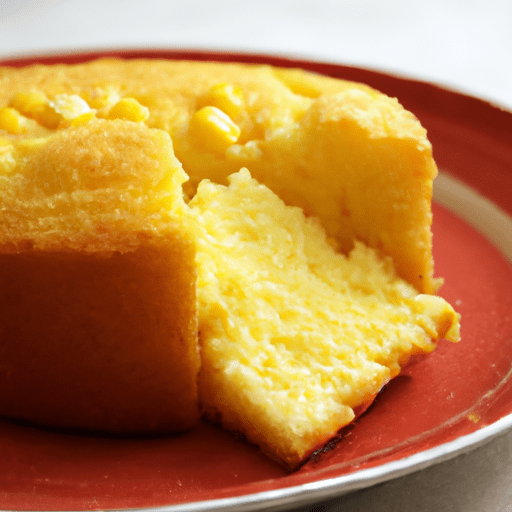The Delicious World of Corn Bread
Corn bread is a beloved staple in many cuisines around the world. This delightful and versatile bread is enjoyed for its unique taste and texture. Whether you enjoy it as a side dish, a base for recipes, or as a delicious snack, corn bread is sure to satisfy your cravings. In this blog post, we will delve into the wonderful world of corn bread, exploring its taste, common uses in cooking, nutritional value, and some interesting history and facts.
Taste and Texture
Corn bread has a distinctively rich, slightly sweet, and earthy flavor. It is often described as having a crumbly and tender texture, with a slight grittiness due to the presence of cornmeal. The combination of cornmeal with other ingredients, such as flour, eggs, sugar, and butter, contributes to the delightful contrast of flavors and textures found in corn bread.
Versatile Uses in Cooking
Corn bread is incredibly versatile and can be enjoyed in various forms. Here are some common uses of corn bread in cooking:
1. Side Dish: Corn bread pairs perfectly as a side dish with hearty soups, stews, or chili. Its slightly sweet flavor complements the savory nature of these dishes, creating a delightful balance on your plate.
2. Stuffing: Crumbled corn bread is often used as a base for stuffing recipes. Its ability to absorb flavors and retain moisture add a unique twist to traditional stuffing dishes.
3. Casseroles: Corn bread can be incorporated into numerous casserole recipes, giving them a wonderful depth of flavor and a satisfying texture. It adds a delicious twist to classics like cornbread pudding and corn casserole.
4. Breakfast Delight: Corn bread can be transformed into a delicious breakfast treat. Served warm with a drizzle of honey or paired with bacon and eggs, it makes for a delightful morning meal.
Nutritional Value
Corn bread not only tantalizes our taste buds but also offers some nutritional benefits. Here are some key nutrients found in corn bread:
Fiber: Cornmeal, the primary ingredient in corn bread, is rich in dietary fiber, aiding digestion and promoting a healthy gut.
Protein: Corn bread contains protein, albeit in smaller amounts compared to other protein-rich foods. It contributes to overall nutrition and satiety.
Vitamins and Minerals: Corn bread is a source of essential vitamins and minerals, including vitamin B6, niacin, folate, and iron.
While corn bread does contain calories, the nutritional value can be enhanced by using healthier ingredients like whole-grain cornmeal, reducing sugar, and incorporating nutritious add-ins such as vegetables or herbs.
History and Fun Facts
Corn bread has a long history, deeply entwined with the culinary traditions of various cultures. Here are some fascinating facts about this beloved bread:
Native American Roots: Corn bread traces its origins back to Native American cuisine, specifically the indigenous tribes in present-day North and South America. They utilized corn as a fundamental staple in their diet and created corn-based breads, including what we now know as corn bread.
Colonial Influence: Corn bread gained popularity during the colonization of the Americas. The European settlers embraced corn as a staple grain and adapted their traditional bread-making techniques to incorporate this abundant ingredient.
Regional Variations: Corn bread exhibits a remarkable diversity across different regions and cultures. From Southern cornbread made with buttermilk and baked in a cast-iron skillet to the sweeter Northern-style cornbread made with flour and sugar, there is a delightful corn bread variation to suit every palate.
National Corn Bread Festival: In South Pittsburg, Tennessee, the National Corn Bread Festival is celebrated annually with grandeur. Visitors can indulge in corn bread samples, witness various corn bread cooking competitions, and explore the rich history and flavors of this quintessential bread.
Conclusion
Corn bread, with its distinctive taste, versatility in cooking, and rich historical significance, is undoubtedly a culinary treasure. Its ability to complement a wide range of dishes and provide comfort and satisfaction is truly remarkable. So, whether you choose to bake your own batch at home or savor it at your favorite restaurant, be prepared to embark on a delectable journey into the fascinating world of corn bread.
Corn Bread
Origin: Corn bread is a traditional bread that originated in Native American cuisine. Native Americans were the first to grind corn into meal and use it in their cooking. Corn bread recipes have been passed down through generations, and it remains an important part of American culinary history.
Common uses: Corn bread is often served as a side dish or accompaniment to meals. It is commonly enjoyed with chili, soups, stews, and barbecue. In some regions, it is also used to make stuffing or as a base for cornbread dressing.
Nutritional benefits: Corn bread can provide several nutritional benefits. It is a good source of carbohydrates and dietary fiber. The cornmeal used in corn bread usually retains some of the nutrients from corn, such as iron, magnesium, and vitamin B-6. However, the nutritional content can vary depending on the recipe and ingredients used.
Unique properties: Corn bread has a distinct yellow color and a slightly sweet and crumbly texture. It gets its characteristic flavor from the cornmeal used in the recipe. The use of cornmeal gives it a slightly grainy texture compared to bread made with wheat flour. Corn bread can be baked in a variety of forms, such as muffins, loaves, or as part of a skillet dish.
Historical significance: Corn bread has been a staple food in many cultures throughout the Americas for centuries. It played a significant role in the diet of the Native Americans and later became popular among European settlers. During the American Civil War, corn bread became an important food source due to its availability and ease of preparation. It has since become a beloved comfort food in American cuisine.




Use the share button below if you liked it.
It makes me smile, when I see it.